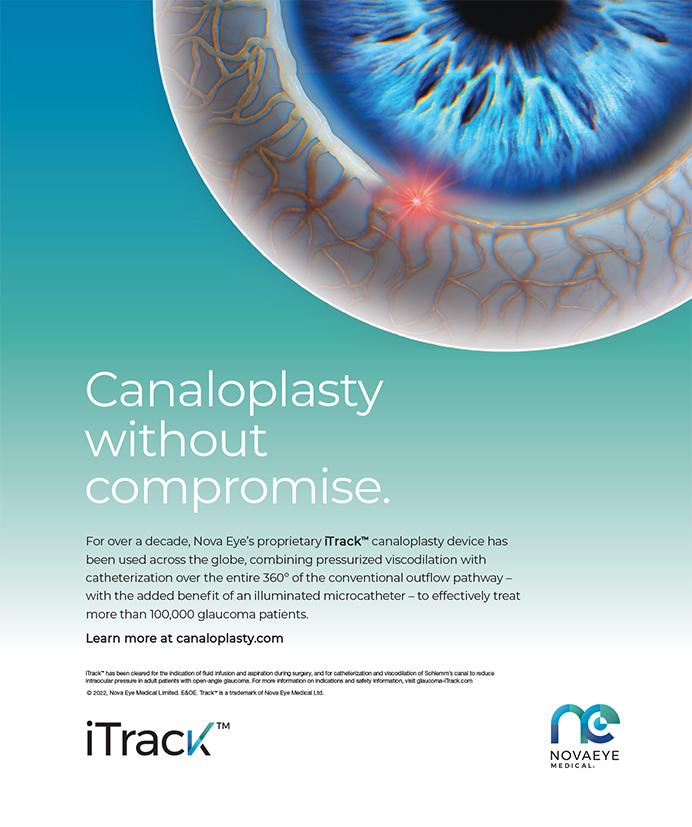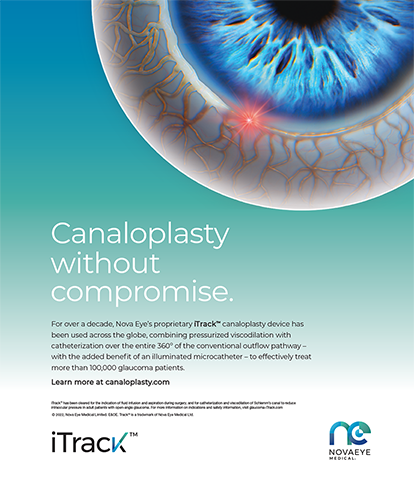Assuming that the IOL's power is correct, there are four problems that typically require a lens to be repositioned. In my experience, repositioning is needed when (1) a toric lens is off axis, (2) a multifocal lens is decentered, (3) one of the haptics of a single-piece lens is out of the capsular bag, causing pigment dispersion and secondary glaucoma, and (4) a sulcus-fixated lens is decentered. This article describes my techniques for addressing these scenarios, as well as how I approach a dislocated lens-bag complex.
HOW I CORRECT THE COMMON CULPRITS
I use the same technique to correct a misaligned toric IOL and a decentered multifocal IOL. First, I lift the edge of the capsulorhexis with a Sinskey hook or similar instrument, and then I viscodissect the IOL free. The problem with many single-piece acrylic IOLs is that the bulb at the distal end of the haptic is totally ensconced by the capsule. The viscodissection, therefore, must release the haptic to ensure the bulb is free. To accomplish this, I start viscodissecting at the optic haptic junction and inject viscoelastic along the haptic out to the bulb. It is important not to attempt to break the bulb free by pulling centrally but to instead follow the anatomy of the capsule and rotate the lens. Occasionally, I amputate the haptic and then exchange the lens.
When the haptic is out of the capsule and causes pigment dispersion, I viscodissect open the capsular bag and place the haptic inside the capsular bag. If this approach is not successful and the IOL is stable, I amputate the haptic; nothing further needs to be done.
A decentered sulcus-fixated IOL can occur after trauma or because the implanted lens was inappropriate for sulcus fixation. Although the surgeon can exchange the IOL for a more appropriate lens such as STAAR Surgical's AQ5010V IOL, this step is not necessary if the original IOL's power is correct. In this case, I would fixate the IOL to the iris with a 10–0 Prolene suture (Ethicon, Inc.).1 If the surgeon prefers, he or she can also exchange the IOL for an ACIOL or iris-claw IOL.
HOW I APPROACH A DISLOCATED LENS-BAG COMPLEX
A dislocated lens-bag complex presents a challenge. This situation is most commonly seen as a spontaneously subluxated complex in patients with pseudoexfoliation that occurs on average 8.5 years after uncomplicated cataract surgery (Figure 1).2 This complication, however, can occur after trauma or in patients with retinitis pigmentosa or chronic uveitis.
Care must be taken to thoroughly plan the surgery. It is important to discern if the dislocated lens-bag complex can be approached solely from the anterior segment. It is also critical to position the patient supine to see if the IOL dislocates. If the IOL subluxes posteriorly, then a retinal team will place three pars plana ports, perform a vitrectomy, and elevate the IOL. If the IOL is stable, I fixate the lens to the sclera or, alternatively, I will glue the IOL using Amar Agarwal's technique.3 Although it may be technically easy to fixate the IOL to the iris, I find that eyes that have undergone a complete vitrectomy tend to have significant pseudophacodonesis. These eyes can also have chronic inflammation or even recurrent hyphema.
If a vitrectomy is not needed, then several approaches can be considered. A three-piece IOL can be fixated to the iris by bringing the lens' optic into the anterior chamber, inducing miosis with acetylcholine chloride (Miochol-E; Bausch + Lomb) or carbachol solution 0.01% (Miostat; Alcon Laboratories, Inc.) and then securing the lens using a 10–0 Prolene suture with a CTC-6L needle (Ethicon Inc.) and Siepser sliding knots.1 The advantage of this technique is that the surgeon can complete the maneuvers through small stab incisions.
If the lens-bag complex is solid or has a capsular tension ring, then, in my experience, it is best to suture the lens to the sclera (Figure 2). In this case, I use 9–0 Prolene suture to secure the complex. Next, I create two conjunctival peritomies 180º apart. Using a 23-gauge microvitreoretinal blade, I create two sclerotomies 2 mm posterior to the limbus about 3 mm apart.4-7 I pass the CTC needle through one site, then bring it under and through the lens-bag complex (Figure 3). Next, using a snare (MicroSurgical Technology) designed by Garry Condon, MD,8 I grab the suture above the lens-bag complex, forming a lasso around it. The same procedure is done on the other side, and the lens is secured.
If the lens is the wrong power due to an error in calculation or damage, then an exchange is necessary. For this procedure, I fixate an ACIOL (ZC70BD; Alcon Laboratories, Inc.) on the iris or sclera (preferably the sclera) with an 8–0 GoreTex suture (W. L. Gore & Associates, Inc.). Next, I create two conjunctival peritomies as described previously. I then place the suture through the eyelets of the IOL. Finally, I place the sutures into the anterior chamber and retrieve the secondary IOL with the snare or 25-gauge internal-limiting membrane forceps.
After all of these maneuvers, it is important to use triamcinolone to identify any vitreous that is anterior to the IOL and use a modern 23-gauge vitrectomy handpiece (2,500 cuts/min) to clear the anterior segment.
CONCLUSION
Repositioning an IOL can present interesting and sometimes complex surgical issues. Careful surgical planning and making sure the surgeon has the necessary tools available will help ensure an excellent outcome.
Alan S. Crandall, MD, is a professor, the senior vice chair of ophthalmology and visual sciences, the director of glaucoma and cataract, and the codirector of the International Division for the John A. Moran Eye Center at the University of Utah in Salt Lake City. He is a consultant to Alcon Laboratories, Inc. Dr. Crandall may be reached at (801) 585-3071; alan.crandall@hsc.utah.edu.
- Siepeser SB. The closed chamber slipping suture technique for iris repair. Ann Ophthalmol. 1994;26(3):71-72.
- Jehan FS, Mamalis N, Crandall AS. Spontaneous late dislocation of intraocular lens within the capsular bag in pseudoexfoliation patients. Ophthalmology. 2001;108;1727-1731.
- Kumar DA, Agarwal A. Glued intraocular lens: a major review on surgical technique and results. Curr Opin Ophthalmol. 2013;24(1):21-29.
- Ahmed IIK, Crandall AS. Ab externo scleral fixation of the Cionni modified capsular tension ring. J Cataract Refract Surg. 2001;27:977-981.
- Assia EI, Ton Y, Michaeli A. Capsule anchor to manage subluxated lenses: initial clinical experience. J Cat Refract Surg. 2009;35:1372-1379.
- Hasanee K, Butler M, Ahmed IIK. Capsular tension rings and related devices: current concepts. Curr Opin Ophthalmol. 2006;17:31-41.
- Slade DS, Hater MA, Cionni RJ, Crandall AS. Ab externo scleral fixation of intraocular lens. J Cataract Refract Surg. 2012;38(8):1316-1321.
- Condon GP. Simplified small-incision peripheral iris fixation of an AcrySof intraocular lens in the absence of capsule support. J Cataract Refract Surg. 2003;29(9):1663-1667.


